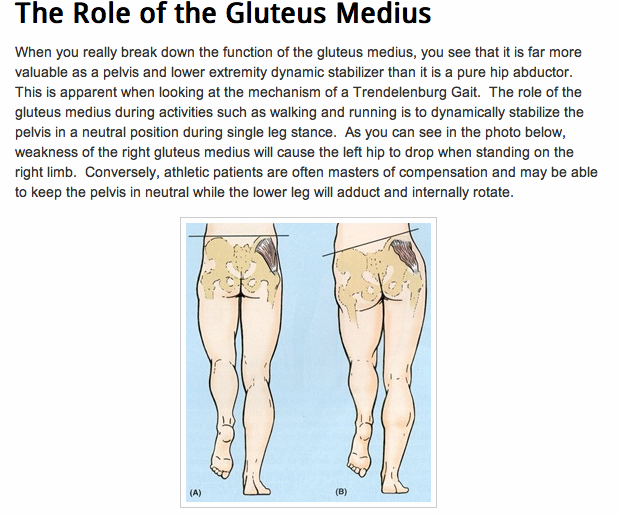Even when you have the right instruction, but come with poor alignment and poor glute strength, performing correct movements is a huge challenge. It's no secret that some athletes learn quickly, because they they have well developed muscle groups and control, but not all athletes.
I have watched my friend Tom Barbeau, who is a Burdenko practitioner, put many athletes through a preliminary muscle testing session. What is amazing about this is the lack of flexibility and strength in "thought to be" very strong and young athletes. These deficiencies really show up in glutei area balancing and hip control exercises. So no one is immune to Glutei area deficiency.
Let's look at what constitutes a correct movement, and engagement of glute muscles, the results of the kinetic chain in action.. In PMTS we teach ankle eversion to set the ski on edge, without knee drive or foot and leg steering. If you dissect the abilities that result from this movement, we see an outside knee more inline (straighter) to and with a long leg. This directs the forces to line up to the pelvis, going through the knee, almost perfectly through the center of the knee. This requires that the muscles on your backside be engaged, to keep the pelvis stable and level. The primary muscle I'm referring to is the gluteus medius.
A comment about alignment and boots a this point is appropriate. With correct alignment the above ideal situation is achievable for most skiers, but with a knocked kneed stance it's almost impossible to achieve vertical hips, and slightly bowed knees. A strong body alignment, is looking at the hips from the side, the hips should stay in line with a fairly straight outside leg in the loaded phase of the turn. What we see more often is an anterior tilt (top of hips forward, butt back) to the hips and knees together.

Many will remember the images I put up years ago (link below) of me standing on a box and lowering and lifting the pelvis on one side. Notice that the top of my hips don't tilt forward. This exercise or movement is key to success for skiing with strength and power generated by angles from the ski, without using unneeded muscle effort. Correct use and well developed glutei package also helps to learn unwanted movements developed from incorrect technique. With all things going right, and moving with the correct techniques, keeping the hips and your body level is essential for mastering PMTS and higher levels of skiing.
Now imagine if you are told to ski by twisting or turning your foot or ski. This also begins a series of movements up the body that are part of a kinetic chain, but a highly destructive chain. To create this movement you must let go of the Glute medius's and maximus's control of hip counter and femur internal rotation. The very movement that is taught, "steering" unhinges the gluteus muscles that hold and can create CA.
In my experience over the years teaching skiers who learned with knee drive, foot and leg steering, that reversing the damage done is a serious process and I know the reasons for this even more today, than when I wrote my first book. PMTS development and learning about skier movements never stops at Harb Ski systems.
The actions of starting the correct kinetic reaction up the body provides many benefits as well. First the ankle eversion movement stabilizes the ankle against the side of the boot for support, this in turn keeps the ski edge engaging and gives the upper body more control in lateral balancing. If you begin with the foot steering, this is functionally a ski flattening move, and recruits bigger muscles such as the adductors and releases the hip into rotation. Foot steering unlocks the glutei group of muscles so that the adductors and femur rotators can exert twist to the ski. The mere thought of steering in any form, reduces the activity that holds the hip in balance relative to the upper body mass, toward a loaded ski edge.
On the Harb Ski Systems web site you'll find this article about hip counter-balancing I referred to earlier.
http://harbskisystems.com/index.php?option=com_content&view=article&id=232:the-pelvis-in-counterbalancing-sp-26050&catid=43:tech-articles&Itemid=311
The gist of all this is to help you prepare better for the season to maximize your skiing potential. What are the best exercises for glutei area development. There are many, and if you Google for information about these exercises, you'll see many different approaches. It's important to recognize how to engage and where your glutei group resides and reacts in your body to movements. One video online I saw showed the "Clam Shell" exercise, with precise instruction on how to control and contract the right muscles. It's important to note when you are doing typical glutei exercises other muscles groups are recruited, if you don't have a real sense of the correct way of performing the exercises, you may not be gaining what you want. One exercise I found useful is seated leg press, with a stretch band around your legs above the knees. Keeping the knees moving apart as the leg press is performed keeps the glutes doing the right thing to control internal rotation.
Here are some references:
This is a series of 4 videos with explanations basically the same, but somewhat tedious. The information is for learning where and how your glutei medius is used. More exercises include: front and side lunges with or without a box or bench. Move into tele-hops (shown on the pmts training program with weights or kettle bells. Rubber stretch cords are very useful, for behind the body leg raises. I'll get some photos or video up for some of these exercises. Or look some up on You tube. Form is very important, for example you don't want to collapse you hips or get your knee forward of your feet in lung exercises. Keep everything straight and up right.
